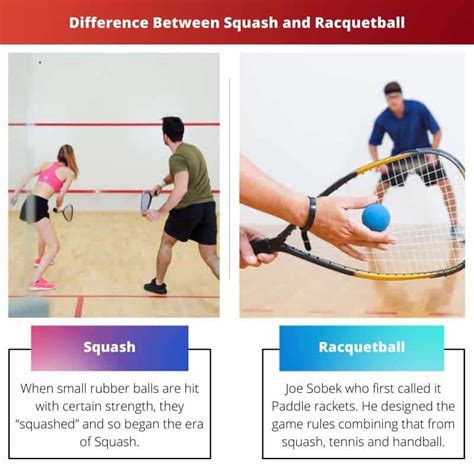Introduction: The Enduring Rivalry
Squash and racquetball have long been considered the dynamic duo of racquet sports, each offering a unique blend of athleticism, strategy, and adrenaline. While they share some similarities, these two sports diverge in several key aspects, captivating enthusiasts and leaving many to ponder which reigns supreme. This in-depth comparison delves into the nuances of each sport, highlighting their strengths, weaknesses, and unique characteristics to help players identify the perfect match for their individual preferences and goals.

Racquet Anatomy: A Tale of Two Tools
The rackets used in squash and racquetball exhibit distinct features that impact the overall gameplay. Squash rackets are typically lighter, ranging from 110 to 160 grams, and feature a narrower head shape. This design allows for lightning-fast reflexes and precise shot placement. Racquetball rackets, on the other hand, weigh between 160 and 225 grams and boast a wider head shape. Their higher weight provides more power behind shots but limits maneuverability in close-quarters rallies.
Court Dimensions: A Matter of Space
The playing environments for squash and racquetball differ significantly in size and proportions. Squash courts measure 9.75 meters long by 6.4 meters wide, creating an intimate and intense atmosphere. The walls enclose the players, offering countless angles and reflections that add a strategic dimension to the game. Racquetball courts are larger, spanning 12.2 meters in length and 6.1 meters in width. The additional space allows for more movement and extended rallies, emphasizing power and endurance.
Ball Dynamics: A Clash of Speeds
The balls used in squash and racquetball exhibit contrasting characteristics that heavily influence the gameplay. Squash balls are smaller and denser than racquetballs, resulting in a faster and more unpredictable bounce. They demand razor-sharp reflexes and quick reactions to anticipate and counter the unpredictable trajectory. Racquetballs, conversely, are larger and bouncier, allowing for more controlled shots and longer rallies. The slower pace of racquetball promotes tactical positioning and shot anticipation.
Game Structure: The Essence of Strategy
The game structures of squash and racquetball vary in terms of scoring and gameplay. Squash matches are typically played as best-of-three or best-of-five games, with each game consisting of 11 points. The rally continues until one player fails to return the ball, and the winner scores a point. Racquetball matches are also played in a best-of-three or best-of-five format, but each game comprises 15 points. The first player to reach 15 points with a margin of at least two points wins the game.
Fitness Requirements: A Test of Endurance
Both squash and racquetball demand a high level of fitness and athleticism. Players must possess exceptional agility, speed, and endurance to navigate the demanding rallies and complex court layouts. Squash places greater emphasis on quick bursts of energy and precise footwork, while racquetball favors sustained endurance and power generation. Regular play in either sport can significantly enhance cardiovascular health, muscular strength, and overall fitness levels.
Safety Considerations: Minimizing Risks
Squash and racquetball, while physically demanding, are generally considered safe sports. However, it is essential to prioritize safety measures to mitigate potential risks. Wearing protective eyewear is paramount to prevent eye injuries, which can be caused by the fast-moving balls. Proper footwear and cushioning on court surfaces help minimize the risk of slips, falls, and ankle sprains. Following proper warm-up and cool-down routines can also help reduce muscle strains and injuries.
Learning Curve: Embracing the Challenges
Becoming proficient in squash or racquetball requires a combination of natural talent, consistent practice, and expert coaching. Squash is renowned for its steep learning curve, demanding both physical prowess and exceptional hand-eye coordination. It typically takes several months or even years to master the game’s intricacies and develop a consistent winning strategy. Racquetball, while still challenging, offers a slightly gentler learning curve. The larger court and slower pace allow beginners to grasp the basic techniques more quickly and experience a sense of accomplishment early on.
Social Impact: Fostering Community
Squash and racquetball offer opportunities for socialization and camaraderie beyond the competitive realm. Many clubs and organizations host tournaments, social events, and group lessons, creating a welcoming environment for players of all levels. These gatherings provide opportunities to connect with like-minded individuals, learn from experienced players, and foster a sense of community. The social aspect of squash and racquetball adds to their appeal and makes them enjoyable not only as competitive sports but also as recreational activities.
Which Sport Rules Your Racquet?
The choice between squash and racquetball ultimately depends on individual preferences, strengths, and goals. If you prefer a fast-paced, highly technical game that demands quick reflexes and court coverage, squash may be the ideal sport for you. Racquetball, on the other hand, offers a more forgiving learning curve, longer rallies, and a stronger focus on power and endurance.
Embracing Inclusivity: Squash and Racquetball for All
Both squash and racquetball have been gaining popularity among a diverse range of individuals, including women, seniors, and athletes with disabilities. Adaptive equipment and modifications have been developed to ensure that everyone can enjoy the benefits of these sports. By embracing inclusivity, squash and racquetball foster a welcoming environment where all players can feel empowered, regardless of their abilities or backgrounds.
FAQs: Addressing Common Questions
Q: Which sport is more popular worldwide?
A: Squash is played in over 185 countries, while racquetball is popular in approximately 70 countries.
Q: Which sport requires more skill and athleticism?
A: Both sports demand high levels of skill and athleticism, with squash placing more emphasis on precision and finesse, while racquetball favors power and endurance.
Q: Is it easier to learn squash or racquetball?
A: Racquetball offers a slightly easier learning curve due to the larger court and slower ball speed.
Q: Which sport is more dangerous?
A: Both sports are relatively safe when played with proper precautions, such as wearing protective eyewear and following warm-up and cool-down routines.
Q: Can I play squash or racquetball if I have a physical disability?
A: Yes, adaptive equipment and modifications are available to allow individuals with disabilities to participate in both sports.
Q: What are the best ways to improve my squash or racquetball skills?
A: Consistent practice, expert coaching, and participation in drills and tournaments are effective methods to enhance your skills.
Key Findings: A Comparative Summary
Squash:
- Smaller, denser ball for faster and unpredictable bounce
- Narrower rackets for quick reflexes and shot placement
- Intimate court size for intense and strategic gameplay
- Steep learning curve due to technical demands
- Emphasizes quick bursts of energy and footwork
Racquetball:
- Larger, bouncier ball for slower and more controlled pace
- Wider rackets for more power and reach
- Larger court size for extended rallies and movement
- Gentler learning curve due to more forgiving gameplay
- Favors sustained endurance and power generation
Conclusion: An Informed Decision
Choosing between squash and racquetball is a matter of personal preference and fitness goals. Squash offers a thrilling and demanding experience that tests reflexes and precision, while racquetball provides a more accessible and power-oriented game. Embrace the unique characteristics of each sport and make an informed decision based on your strengths, weaknesses, and desired playing style. Whether you prefer a fast-paced technical battle or a strategic endurance contest, both squash and racquetball promise an exhilarating and rewarding experience.
